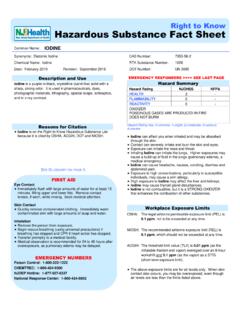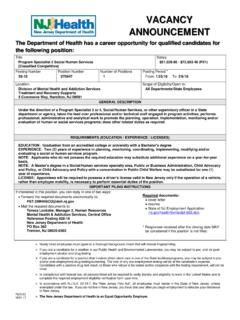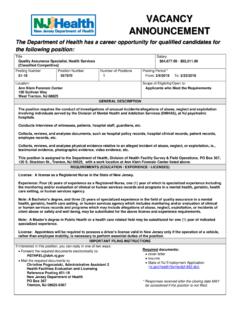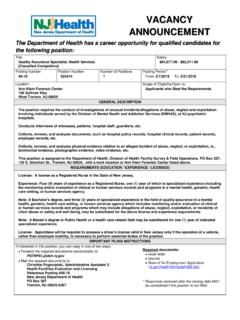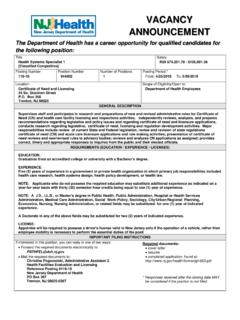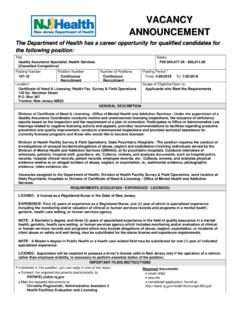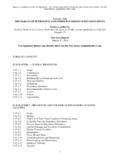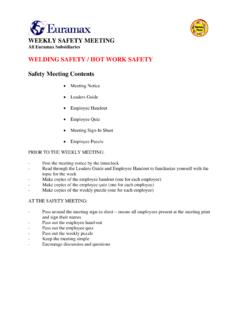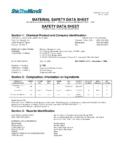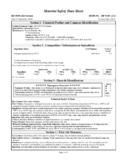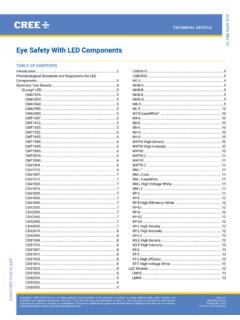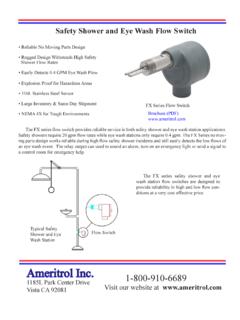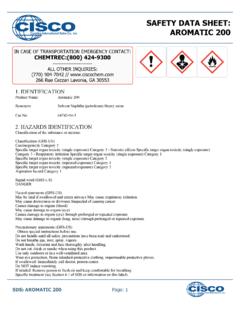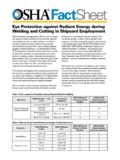Transcription of Right to Know Hazardous Substance Fact Sheet - …
1 Right to Know Hazardous Substance Fact Sheet Common Name: potassium hydroxide . Synonyms: Caustic Potash; Lye; potassium Hydrate CAS Number: 1310-58-3. Chemical Name: potassium hydroxide (KOH) RTK Substance Number: 1571. Date: May 2001 Revision: January 2010 DOT Number: UN 1813. Description and Use EMERGENCY RESPONDERS >>>> SEE LAST PAGE. potassium hydroxide is an odorless, white or slightly yellow, Hazard Summary flakey or lumpy solid which is often in a water solution. It is Hazard Rating NJDOH NFPA. used in making soap, as an electrolyte in alkaline batteries and HEALTH - 3. in electroplating, lithography, and paint and varnish removers. FLAMMABILITY - 0. Liquid drain cleaners contain 25 to 36% of potassium REACTIVITY - 1. hydroxide . CORROSIVE. POISONOUS GASES ARE PRODUCED IN FIRE. DOES NOT BURN. Reasons for Citation Hazard Rating Key: 0=minimal; 1=slight; 2=moderate; 3=serious;. f potassium hydroxide is on the Right to Know Hazardous 4=severe Substance List because it is cited by ACGIH, DOT, NIOSH, NFPA and EPA.
2 F potassium hydroxide can affect you when inhaled and by f This chemical is on the Special Health Hazard Substance passing through the skin. List. f potassium hydroxide is a HIGHLY CORROSIVE. CHEMICAL and contact can severely irritate and burn the skin and eyes leading to eye damage. f Contact can irritate the nose and throat. f Inhaling potassium hydroxide can irritate the lungs. SEE GLOSSARY ON PAGE 5. Higher exposures may cause a build-up of fluid in the lungs (pulmonary edema), a medical emergency. FIRST AID f Exposure to potassium hydroxide can cause headache, Eye Contact dizziness, nausea and vomiting. f Quickly brush off excess chemical from the face. f potassium hydroxide may cause a skin allergy. Immediately flush with large amounts of water for at least 30. minutes, lifting upper and lower lids. Remove contact lenses, if worn, while flushing. Seek medical attention Workplace Exposure Limits immediately. NIOSH: The recommended airborne exposure limit (REL) is Skin Contact 2 mg/m3, which should not be exceeded at any time.
3 F Quickly remove contaminated clothing. Immediately blot or brush off excess chemical and wash gently with large 3. ACGIH: The threshold limit value (TLV) is 2 mg/m , which amounts of soap and water for at least 30 minutes. Seek should not be exceeded at any time. medical attention immediately. Inhalation f The above exposure limits are for air levels only. When skin f Remove the person from exposure. contact also occurs, you may be overexposed, even though f Begin rescue breathing (using universal precautions) if air levels are less than the limits listed above. breathing has stopped and CPR if heart action has stopped. f Transfer promptly to a medical facility. f Medical observation is recommended for 24 to 48 hours after overexposure, as pulmonary edema may be delayed. EMERGENCY NUMBERS. Poison Control: 1-800-222-1222. CHEMTREC: 1-800-424-9300. NJDEP Hotline: 1-877-927-6337. National Response Center: 1-800-424-8802. potassium hydroxide Page 2 of 6. Determining Your Exposure Rproductive Hazard f According to the information presently available to the New f Read the product manufacturer's Material safety Data Jersey Department of Health, potassium hydroxide has Sheet (MSDS) and the label to determine product not been tested for its ability to affect reproduction.
4 Ingredients and important safety and health information about the product mixture. Other Effects f potassium hydroxide can irritate the lungs. Repeated f For each individual Hazardous ingredient, read the New exposure may cause bronchitis to develop with coughing, Jersey Department of Health Hazardous Substance Fact phlegm, and/or shortness of breath. Sheet , available on the RTK website f Skin allergy may occur with itching, redness and/or an rash. ( ) or in your facility's RTK If allergy develops, very low future exposure can trigger Central File or Hazard Communication Standard file. symptoms. f You have a Right to this information under the New Jersey Worker and Community Right to Know Act and the Public Employees Occupational safety and Health (PEOSH) Act Medical if you are a public worker in New Jersey, and under the Medical Testing federal Occupational safety and Health Act (OSHA) if you Before beginning employment and at regular times thereafter, are a private worker. (at least annually), the following are recommended: f The New Jersey Right to Know Act requires most f Lung function tests employers to label chemicals in the workplace and requires public employers to provide their employees with If symptoms develop or overexposure is suspected, the information concerning chemical hazards and controls.
5 Following are recommended: The federal OSHA Hazard Communication Standard (29. f Consider chest x-ray after acute overexposure CFR ) and the PEOSH Hazard Communication f Evaluation by a qualified allergist can help diagnose skin Standard ( 12:100-7) require employers to provide allergy. similar information and training to their employees. f Exam of the eyes and vision This Fact Sheet is a summary of available information Any evaluation should include a careful history of past and regarding the health hazards that may result from exposure. present symptoms with an exam. Medical tests that look for Duration of exposure, concentration of the Substance and other damage already done are not a substitute for controlling factors will affect your susceptibility to any of the potential exposure. effects described below. Request copies of your medical testing. You have a legal Right to this information under the OSHA Access to Employee Health Hazard Information Exposure and Medical Records Standard (29 CFR ).
6 Acute Health Effects Mixed Exposures The following acute (short-term) health effects may occur f Smoking can cause heart disease, lung cancer, immediately or shortly after exposure to potassium emphysema, and other respiratory problems. It may worsen hydroxide : respiratory conditions caused by chemical exposure. Even if you have smoked for a long time, stopping now will reduce f Contact can severely irritate and burn the skin and eyes with your risk of developing health problems. possible eye damage. f Contact can irritate the nose and throat. f Inhaling potassium hydroxide can irritate the lungs causing coughing and/or shortness of breath. Higher exposures may cause a build-up of fluid in the lungs (pulmonary edema), a medical emergency, with severe shortness of breath. f Exposure to potassium hydroxide can cause headache, dizziness, nausea and vomiting. Chronic Health Effects The following chronic (long-term) health effects can occur at some time after exposure to potassium hydroxide and can last for months or years: Cancer Hazard f According to the information presently available to the New Jersey Department of Health, potassium hydroxide has not been tested for its ability to cause cancer in animals.
7 potassium hydroxide Page 3 of 6. Workplace Controls and Practices Eye Protection Very toxic chemicals, or those that are reproductive hazards or f For solid potassium hydroxide wear eye protection with sensitizers, require expert advice on control measures if a less side shields or goggles. toxic chemical cannot be substituted. Control measures f Wear indirect-vent, impact and splash resistant goggles include: (1) enclosing chemical processes for severely when working with liquids. irritating and corrosive chemicals, (2) using local exhaust f Wear a face shield along with goggles when working with ventilation for chemicals that may be harmful with a single corrosive, highly irritating or toxic substances. exposure, and (3) using general ventilation to control f Do not wear contact lenses when working with this exposures to skin and eye irritants. For further information on Substance . workplace controls, consult the NIOSH document on Control Banding at Respiratory Protection Improper use of respirators is dangerous.
8 Respirators The following work practices are also recommended: should only be used if the employer has implemented a written program that takes into account workplace conditions, f Label process containers. requirements for worker training, respirator fit testing, and f Provide employees with hazard information and training. f Monitor airborne chemical concentrations. medical exams, as described in the OSHA Respiratory f Use engineering controls if concentrations exceed Protection Standard (29 CFR ). recommended exposure levels. 3. f Provide eye wash fountains and emergency showers. f Where the potential exists for exposure over 2 mg/m , use a f Wash or shower if skin comes in contact with a Hazardous NIOSH approved full facepiece negative pressure, air- material. purifying, particulate filter respirator with an N, R or P95. f Always wash at the end of the workshift. filter. More protection is provided by a full facepiece f Change into clean clothing if clothing becomes respirator than by a half-mask respirator, and even greater contaminated.
9 Protection is provided by a powered-air purifying respirator. f Do not take contaminated clothing home. f Leave the area immediately if (1) while wearing a filter or f Get special training to wash contaminated clothing. cartridge respirator you can smell, taste, or otherwise detect f Do not eat, smoke, or drink in areas where chemicals are potassium hydroxide , (2) while wearing particulate filters being handled, processed or stored. abnormal resistance to breathing is experienced, or (3) eye f Wash hands carefully before eating, smoking, drinking, irritation occurs while wearing a full facepiece respirator. applying cosmetics or using the toilet. Check to make sure the respirator-to-face seal is still good. If it is, replace the filter or cartridge. If the seal is no longer In addition, the following may be useful or required: good, you may need a new respirator. f Consider all potential sources of exposure in your workplace. f For solid potassium hydroxide , use a vacuum to reduce You may need a combination of filters, prefilters or cartridges dust during clean-up.
10 DO NOT DRY SWEEP. to protect against different forms of a chemical (such as vapor and mist) or against a mixture of chemicals. 3. f Where the potential exists for exposure over 20 mg/m , use a NIOSH approved supplied-air respirator with a full Personal Protective Equipment facepiece operated in a pressure-demand or other positive- pressure mode. For increased protection use in combination The OSHA Personal Protective Equipment Standard (29 CFR with an auxiliary self-contained breathing apparatus or an ) requires employers to determine the appropriate emergency escape air cylinder. personal protective equipment for each hazard and to train employees on how and when to use protective equipment. Fire Hazards The following recommendations are only guidelines and may If employees are expected to fight fires, they must be trained not apply to every situation. and equipped as stated in the OSHA Fire Brigades Standard (29 CFR ). Gloves and Clothing f Avoid skin contact with potassium hydroxide .
